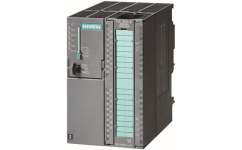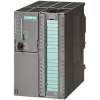Customer benefits
The targeted stopping of a drive by means of SS1 reduces the risk of danger, increases the productivity of a machine, and allows the safety clearances in a machine to be reduced. The principle is to bring the drive actively to a standstill, compared with just using the STO function. Complex mechanical brakes that are susceptible to wear are not normally required to brake the motor.
Safely-Limited Speed (SLS)
The SLS function monitors the drive to ensure that it does not exceed a preset speed or velocity limit.
Effect
The SLS function monitors the drive against a parameterized speed limit. Four different limit values can be selected. The speed setpoint is not influenced independently. After SLS has been selected, the higher-level control must bring the drive down below the selected speed limit within a parameterizable time. If the speed limit is exceeded, a customizable drive-integrated fault reaction occurs.
The SLS limit stage 1 can be multiplied by a factor that is transferred in 16-bit resolution via PROFIsafe. This allows an almost unlimited number of limits to be specified.
Application
The SLS function is used if people are in the danger zone of a machine and their safety can only be guaranteed by reduced speed. Typical application cases include those in which an operator must enter the danger zone of the machine for the purposes of maintenance or setting up, such as a winder in which the material is manually threaded by the operator. To prevent injury to the operator, the roller may only spin at a safely reduced speed. SLS is often also used as part of a two-stage safety concept. While a person is in a less critical zone, the SLS function is activated, and the drives are only stopped in a smaller area with higher potential risk. SLS can be used not only for operator protection, but also for machinery protection, e.g. if a maximum speed must not be exceeded.
Customer benefits
The SLS function can contribute to a significant reduction in downtime, or greatly simplify or even accelerate setup. The overall effect achieved is a higher availability of the machine. Moreover, external components such as speed monitors can be omitted.
Safely-Limited Torque (SLT)
The SLT function monitors the current/torque of a motor.
Effect
The SLT function allows the torque to be reduced within a defined period of time. If the torque exceeds the SLT monitoring limit, the drive responds with a "Safe Stop". The stop responses STO or SS1 can be specified via parameters.
Application
In the simplest case, this function is used for force limiting when opening and closing a protective door on a machine.
Customer benefits
The SLT function avoids the use of external hardware for measuring and limiting the force and the associated wiring effort.
Safe Speed Monitor (SSM)
The SSM function warns when a drive is working below an adjustable speed limit. As long as it remains below the threshold, the function issues a safety-related signal.





